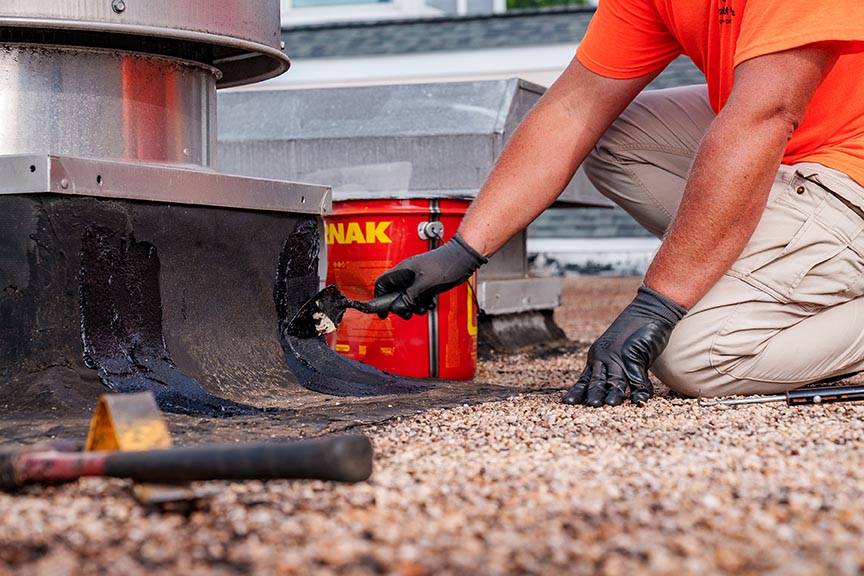How to Protect Your Roof from Summer Storms
The Atlantic Hurricane season runs from June 1st to November 30th. With air and water temperatures continuing to rise each year, these storms are becoming more prevalent and intense. According to the National Hurricane Center, winds can reach 157 miles per hour or higher and can cause catastrophic damage. Even if you don’t live along the coast, hurricanes, tropical storms, and even intense thunderstorms can have a negative effect on your commercial roof. There are three main impacts from summer storms that can damage your commercial roof—hail, wind, and rain.

Hail
Hail is a form of precipitation consisting of solid ice that forms inside thunderstorm updrafts. When hail comes down, it can result in dents and cracks in your roof severely compromising its fundamental integrity. Damage from hail can allow water, moisture, debris, and pests inside your facility, potentially causing structural damage and posing health hazards.
Wind
No matter what type of summer storm occurs, wind is always a factor. High winds can rip off and blow away roofing materials, especially if they are not securely fastened. In addition, lifting and peeling can expose the underlying roof structure resulting in further destruction. Intense windstorms can also damage the fascia and soffit, which might allow water to enter the roof system.
Extreme wind can also have a significant impact on the landscape resulting in falling trees and blowing debris. If any debris hits the roof, it can cause major damage, especially if the roof is punctured.
Rain
Water damage can weaken the roof’s structure and make it unstable and dangerous. Heavy rain events can cause water to pond on a commercial roof making it more likely to leak or corrode, and the weight of standing water can put a strain on the building’s structure. Obstructed gutters may also cause water to back up onto the roof leading to leaks.
Fortunately, there are several things you can do to protect your commercial building roof type from summer storms. This includes a combination of a regular commercial roof maintenance plan, inspections, and employing specific waterproofing and sealing techniques. Some steps to ensure your commercial roof is well-protected include the following:
Conduct Regular Inspections
By conducting regular commercial roof inspections, you can spot a problem before it becomes a roofing emergency. Select a company like Capital Roof Care that offers a variety of service levels to meet your needs.
Commercial roof assessments should be conducted at least twice a year and after a severe storm. Check for any type of damage including cracks, punctures, and blisters. You also need to ensure all seals are intact around vents, skylights, and HVAC units to prevent potential leaks.
Keep the roof clear of leaves, branches, and other debris that can block drainage systems. If any trees are overhanging the roof, trim the branches to reduce potential debris and falling limbs. You should also check to ensure all gutters, downspouts, and drains are free of obstructions that could result in water accumulation.
Prevent Issues by Waterproofing
When it comes to membrane systems you should use a waterproof membrane such ethylene propylene diene terpolymer (EPDM) coating, thermoplastic olefin (TPO) roof coating, or PVC (polyvinyl chloride) coating for an added layer of protection. Applied liquid coatings, like silicone and acrylic can seal and waterproof a roof’s surface, adding another level of protection. Using high-quality sealants and caulk around seams, joints, and penetrations will also prevent water ingress.
If you find a leak, immediately report it by contacting a roofing professional like Capital Roof Care. Even a small leak can lead to big issues for your facility if not addressed quickly.
Address Vulnerable Areas
Several areas of your commercial roof are susceptible to water damage, so ensure the flashings around chimneys, vents, and skylights are correctly installed and maintained. Inspect and maintain parapet walls to guarantee they are watertight. Check and preserve expansion joints to confirm they are appropriately sealed and confirm the scuppers and roof drains are properly sized and installed to manage heavy rainfall.
By implementing these strategies, commercial roofs can be effectively protected against the damaging effects of summer storms, ensuring longevity and reducing the risk of costly repairs. If you haven’t entered into a commercial roof maintenance plan with a professional roofing company, contact Capital Roof Care.
Sources: